Book Reviews
by Max Ink Staff Writers
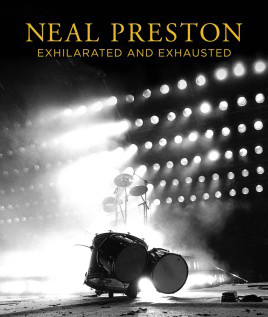
Neal Preston: Exhilarated and Exhausted
Neal Preston: Exhilarated and Exhausted
Author: Neal Preston
Review By Michael Sherer
Publisher: Reel Art Press
Posted: Nov 2017
(6964) Page Views
“I want the reader at the end of this book to feel like they’ve just spent a year on the road with Zeppelin with one day off, then six months with Guns ‘n’ Roses, with one day off and then five years with Bruce Springsteen. Exhilarated and exhausted.” - Neal Preston
Neal Preston is one of the most published, known and respected music based photographers of modern times. He was busiest as a young man with the stamina to be working almost constantly during rock’s golden age: The 1970’s.
This excellent and finely crafted book from Reel Art Press is a retrospective of Preston’s entire career. With a foreword by Neal’s best friend, esteemed screenwriter and film director Cameron Crowe, and an introduction by Preston, the elusive mood, ethos and depth of Preston’s work is set from its start.
The book represents the first time that Preston has allowed full access to his vast archive, stretching back fifty years. 335 large pages of this robust collection still doesn’t cover all of the dozens of artists that Preston has photographed, often intimately. In addition to the performance images, portraits, backstage scenes, outtakes and personal moments that only someone with this kind of access could attain, thoughtful and insightful running commentary by Preston accompanies the striking images. This is a window into understanding the man behind the camera, and Preston clearly put a lot of time and effort into his choice of words.
Anyone that truly understands photography knows that access and how to use it is absolutely key, and Preston was in the driver’s seat as he was the official tour photographer for many bands and artists, thereby allowing him coveted and complete access. Led Zeppelin, Queen, The Who, Bruce Springsteen and Guns ‘n’ Roses are some of the employers of Preston as their official lensman as they toured extensively. Zeppelin is the band most closely associated with Preston, and they were, of course, one of the very biggest and charismatic groups of their time. They were also the least media friendly, wanting to maintain a certain mystique. However, they and their highly intimidating and protective manager, Peter Grant, (a huge man that had been a wrestler amongst other occupations) welcomed Preston in with open arms.
Preston, 65, was just the right age (as were the artists themselves) to have the maturity, natural talent and instincts, but also and very importantly the great drive and strength of youth to take on the highly demanding grind that these tours posed. The books’ title obviously reflects the thrill of capturing the images of an ambitious insider, yet at the cost of comprehensive exhaustion.
Preston says “Shooting live music performances is something few photographers do really well. I just happened to discover one day that I was pretty good at it.” Indeed he is, and Preston’s images are the visual fodder of rock and roll’s most glorious times. In my view we’ll never see such an exciting and inspired confluence of forces again in real life, but within these pages we’ll never not. Grab it.
Author Neal Preston Online
• Website
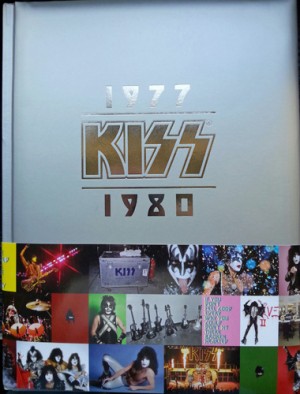
All photography by Lynn Goldsmith
KISS - 1977-1980, Photography by Lynn Goldsmith
Author: Lynn Goldsmith
Review By Michael Sherer
Publisher: Rizzoli
Posted: Oct 2017
(7067) Page Views
Celebrated and veteran photographer Lynn Goldsmith, in conjunction with top shelf (no pun intended) book publisher Rizzoli, has compiled and released an excellent presentation of the band KISS during their height of popularity, that being 1977 through 1980. With access and trust being key for successful photography, (in addition to the obvious talent, creativity and eye) Goldsmith had that access in spades with the band. While incorporating her own compelling ideas and gifts in her craft, Goldsmith was able to capture stellar images of this highly theatrical and visual group of four distinct personas that comprise KISS. This includes many candid, behind the scenes photos, and a nice mix of color and black and white.
Additionally, Goldsmith worked with founders Gene Simmons and Paul Stanley in having them provide current written commentary throughout the book. They had a very good rapport, being about the same age and sharing Jewish roots. An added plus is that although KISS is from New York City, they first broke in Detroit, a city that truly loves their rock and roll. Goldsmith is from that city and can relate to it all. Relating to a photographer’s subject is important, as it not only allows for an effective exchange but also interesting ideas, which Goldsmith has many, especially with KISS.
This large sized, silver colored book of a few hundred pages is an essential addition to any KISS fan and/or of rock and roll based photography. Highly recommended!
Author Lynn Goldsmith Online
• Website • Facebook
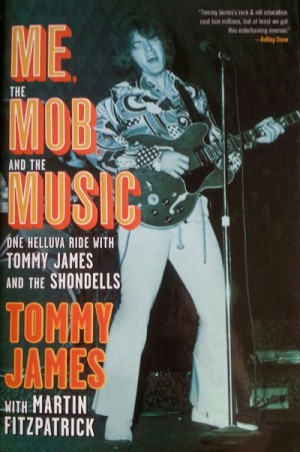
Tommy James
Me, The Mob, And The Music - By Tommy James with Martin Fitzpatrick
Author: Tommy James with Martin Fitzpatrick
Review By Michael Sherer
Publisher: Scribner
Posted: Jul 2016
(6397) Page Views
This compelling book tells the story of how Thomas Jackson, later to be renamed Tommy James, played locally in Niles, Michigan for years until a cover of an obscure song called Hanky Panky in ‘64 was cut. One of a few songs he and his group recorded in a local studio, it was to have huge consequences when two years later a radio DJ in Pittsburgh discovered it and began playing it very frequently. It received a rousing response from listeners and Tommy had a big regional hit on his hands. Things snowballed from there, with Tommy taking on a manager who negotiated with several record company executives that were quite interested in signing Tommy and the band. While Tommy went overnight from languishing in small town Michigan to being able to mull over these tantalizing offers from several NYC record company honchos, he was suddenly informed that all of them but one was still interested, that being the infamous Morris Levy and his Roulette Records. It turns out that Levy was a ruthless and feared figure in the industry and had made it clear to all the other executives that Tommy was HIS artist and they had to back off. Not wanting to deal with Levy’s wrath, they did.
Referred to as “The Godfather” of the record business, Levy had been toiling in it since the mid ‘50’s after becoming the owner of the most known of all the jazz nightclubs, Birdland, NYC. (Named after saxophonist Charlie Parker’s nickname.) Along the way he established close ties to the Genovese crime family and other mob figures, earning him this dubious title. Levy’s Roulette hadn’t had a hit for some time, and he wasn’t going to let this one pass him by. It was still the era of hit singles, although that was soon to change.
Full LP record hits began to take over in ‘68, the same year that FM radio surpassed AM. That’s not a coincidence, as it was FM that was playing much longer songs and even full record sides while AM stuck to the top 40, short single format. FM also sounded far better than the mono AM. In addition it had come time for artists to either write their own material or be considered hokey and passe. The Beatles were a big catalyst for this change. Publishing rights and royalties from these original songs is where Levy made a fortune, whereby he hardly payed the artists (or didn’t pay at all) and acquired the publishing of many other labels from their bosses, namely of George Goldner in card games where Goldner needed to sell to pay his gambling debts.
A running and pathetic joke in the industry was that the office of the man that paid royalties to Roulette’s artists was the quietest place in the world because nothing was happening. It all had to be signed off by Levy, and he wouldn’t do much of anything with that. He was known to crack “You want royalties? Go to England.” Tommy and his group was a case of an artist being able to cater fully to both the past singles world and the new one described here, coming on the scene in a very interesting and transitional period.
The book’s central theme is the highly complex, multi faceted relationship between Tommy and Levy. Tommy and his group The Shondells was Roulette’s biggest money maker with many hits coming in, such as “I Think We’re Alone Now,” “Crimson And Clover,” “Money Money” and “Crystal Blue Persuasion.” But as noted, Levy wasn’t paying Tommy, let alone the band, their due royalties. He would stall and make excuses, often that studio costs had to be recouped, which in reality had already happened. Instead Levy would occasionally have his secretary Karin write Tommy a check for typically ten thousand dollars. This was only a tiny fraction of what he was owed, though. For years and years Tommy’s great frustration with not being paid weighed very heavily on him, but at the same time Levy became like a mentor and father figure to him, as well as giving Tommy total creative freedom with his records and providing an exciting and educational atmosphere at the offices where the eager student of the business spent much time. And then there were the industry parties.
Greatly in part from Tommy’s frustrations with Levy, he had personal struggles for many years. He did overcome them, however. Along the way Tommy toured the world and had a hell of an adventure. It’s all documented in this book. Also included are photos of Tommy through the decades. Now 50 years on since Hanky Panky jump started Tommy’s entire career, it’s a good time to read how it all unfolded. I highly recommend this book with it all told from the man himself.
Author Tommy James with Martin Fitzpatrick Online
• Website • Facebook
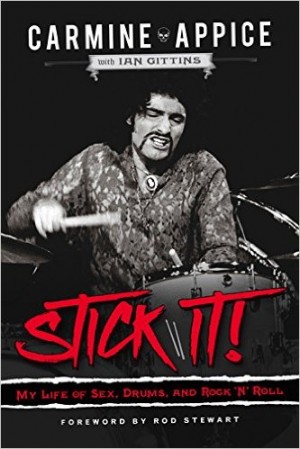
Carmine Appice
Stick It! - My Life of Sex, Drums, And Rock ‘N’ Roll, by Carmine Appice with Ian Gittins
Author: Carmine Appice
Review By Michael Sherer
Publisher: Chicago Review Press
Posted: Jul 2016
(7411) Page Views
This page turning book, written by Carmine with the help of Ian Gittins, tells of the amazing, fifty year plus year journey of one of the most influential, innovative and well known rock drummers of all, and one who has seen and done everything that someone could dream of in living a proverbial rock star life.
Growing up in Borough Park, Brooklyn, a very Jewish and Italian area of NYC, Carmine hung with gangs as a teenager and indulged in some of their hoodlum activities. At least a couple of the other guys wound up going to jail or dying from overdosing. Or were snuffed out from Mafia related reasons upon getting involved with organized crime. Carmine decided that he wasn’t going to go in that doomed direction, and was determined to make it in music instead. After toiling in some other groups trying to make it he joined The Pigeons, another local band, after being highly impressed with their musicianship. They changed their name to the much more interesting Vanilla Fudge when a female fan said after a concert that they sounded like a white soul band, like vanilla fudge. They also found an effective manager in Phil Basile, in good part because he was connected to the mob and owned a big and popular club in Long Island to have them be the house band for.
Fame hit in ‘67 when the band scored a spot on the hugely coveted Ed Sullivan show to perform their slowed down, heavy and organ soaked hit cover of The Supremes’ You Keep Me Hangin’ On. With Sullivan’s variety show breaking open careers, and with the show having a staggering and unheard of 73 million viewers glued to their televisions for the appearance of The Beatles three years earlier in ‘64, this moment would be Carmine’s high water mark, and all at the age of 21. And luckily it happened when it did as Sullivan’s show was cancelled in ‘71 by CBS after a 23 year run when its ratings had dipped significantly.
Carmine discusses a range of interesting tales, such as spending time with Jimi James in The Village in NYC as they were both gigging. James would go on to become a sensation in London and then the world as Jimi Hendrix. Among many other things, we learn of perpetual trashing of hotel rooms, having newly formed Led Zeppelin open for the Fudge on Zep’s first American tour in ‘68, indulging in approximately 4,500 groupies, being in band with Jeff Beck (and how mercurial he is) and sexual tag team buddy/bassist Tim Bogert as BBA in the early ‘70’s, playing with mega star and former Jeff Beck Group singer Rod Stewart for several years and touring the world first class with him, touring with Ozzy Osbourne and then being fired by Ozzy’s wife and manager Sharon when she felt he was grabbing too much attention as a big name, getting married five times, and finally finding his soul mate in the 2000’s, radio personality Leslie Gold, with whom Carmine is still happily with. While Carmine, now 69, has settled down, this book looks all the way back and lets it all hang out. Plus there are great photos in it, with one taken by me. Go get it.
Author Carmine Appice Online
• Website • Facebook
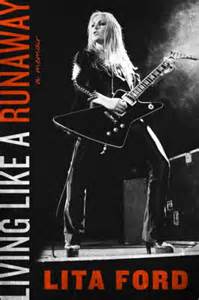
Lita Ford's Autobiography "Living Like A Runaway: A Memoir"
Living Like A Runaway: A Memoir
Author: Lita Ford
Review By Laura Sorensen
Publisher: HarperCollins Publishers
Posted: May 2016
(5904) Page Views
It was impossible for Lita Ford to know how the name of her first band would become part of such an appropriate title for her autobiography 40 years later. At the age of sixteen she became the guitarist for the groundbreaking all female teenage rock band “The Runaways.” Lita blazed a trail for women in rock especially with her amazing guitar playing ability. No one was ready to believe that a female, much less a teenager, could shred the guitar like she could. In her book Lita reveals the trials and tribulations of being part of The Runaways, from management issues to band member conflicts to hardly getting paid for any of it. Her story takes us all the way up to 2015 as she continues to rebound from a fifteen year hiatus and a troubled, painful marriage. Her story is one of hope and inspiration, fear and failure, defeat and conquest. Most of all, it is written from her heart as we get a close look at the inside world of rock and roll from a woman’s point of view.
Love it or hate it Lita Ford connected with a lot of famous rock stars. Some are presented as nice guys, others not so much. It can be a rude awakening to read about people that you thought you admired only to realize they might not be the kind of idol that you really want to follow and model yourself after.
Lita tells it straight from the heart, even when it doesn’t reflect well on her. She is not just a talented musician, she’s an icon, a queen, “The Queen of Heavy Metal” as some have said. I highly recommend this book to anyone who thinks they aren’t good enough, don’t have what it takes, or get their feelings hurt by rejection. If you believe enough in yourself, no one can stop you. Lita is living proof.
Performing: Bratfest, Madison, WI, May 27, 2016
Author Lita Ford Online
• Website • Facebook
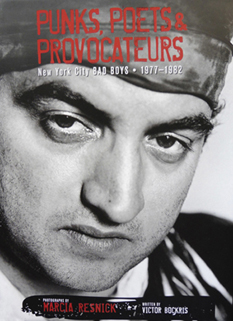
Punks, Poets & Provocateurs: NYC Bad Boys, 1977 - 1982 by Marcia Resnick and Victor Bockris
Punks, Poets & Provocateurs: NYC Bad Boys, 1977 - 1982
Author: Marcia Resnick and Victor Bockris
Review By Michael Sherer
Publisher: Insight Editions
Posted: Feb 2016
(6087) Page Views
In 1977, Marcia Resnick, then 26, began photographing the downtown Manhattan cultural scene. Downtown was “where it was at” for a convergence of rock and roll, jazz, film, literature and art that in retrospect stands as as the counterculture’s last hurrah. And what a hurrah it was. Resnick reflects back on this era by musing “The people from the extraordinary New York milieu amongst whom I was living and working had no way of knowing that the years between 1977 and 1982 were enchanted, endangered, and unrepeatable.” It’s these years that the book covers.
Text by writer Victor Bockris provides much thoughtful insight. There’s also antidotes and accounts from Resnick herself that accompany the images throughout.
This fine, 270 page book focuses mainly on maverick men, i.e., bad boys. Resnick defines a bad boy as those that, as she puts it “Have a special magic, who has charisma, and who braves living on the edge.” Some of the figures that comprise this aesthetic here are the defining beat poets William S. Burroughs, Allen Ginsberg and Gregory Corso, rock and rollers Mick Jagger, Iggy Pop, Johnny Thunders, David Byrne, Joey Ramone and Brian Eno. Under the the provocateurs and raconteurs categories there’s such people as Norman Mailer, Steve Rubell, John Waters, Lester Bangs, Gary Indiana, Andy Warhol, Abbie Hoffman, and the unforgettable man on the cover, John Belushi. There are many more people in all of these spheres, but here’s a taste.
The publisher, Insight Editions, specializes in high quality cultural works that most often include photography and music. Based in San Rafael, CA. They can be viewed at insighteditions.com
Author Marcia Resnick and Victor Bockris Online
• Website • Facebook
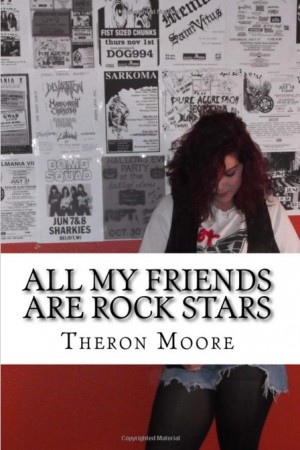
All My Friends Are Rock Stars
All My Friends Are Rock Stars
Author: Theron Moore
Review By Jeff Muendel
Publisher: Mean Machine Press
Posted: Dec 2015
(5957) Page Views
The focus of All My Friends Are Rock Stars is the local rock’n’roll scene during the late eighties and early nineties in the geographical triangle of Rockford, Illinois; Madison, Wisconsin; and Milwaukee, Wisconsin. While that is a fairly narrow spotlight, for those who were involved in those scenes, it makes for an interesting review of the bands, clubs and underground publications of that era. For the wider audience, there are also early stories of bands that made it out of the local scenes to achieve some level of national or international recognition.
Essentially a collection of interviews that often intertwine, Theron Moore has put together a book that could be defined as an oral history of the described upper Midwest rock scene. There are many interesting, funny, and sometimes tragic stories presented about those who toiled for their art in relative anonymity, but the most interesting tend to be about those who clawed their way up to the next level. Interviews include Bun E. Carlos of Cheap Trick, Bill Feeny of The Appliance S.F.B., Dan Hobson of Killdozer, Bucky Pope of The Tar Babies, and Paul Schluter of Last Crack. It’s both fun and cathartic to witness the way in which these groups grew and broadened.
Moore has been freelance writing since 1989, publishing articles and poetry in multiple Midwestern music magazines and websites. In 2011, he edited and self-published his first book, Gangsters, Harlots and Thieves: Down and out at the Hotel Clifton. The author has more books planned for the coming years. All My Friends Are Rock Stars is available on Amazon.com.
Author Theron Moore Online
• Facebook
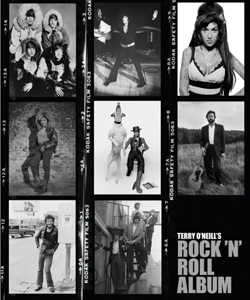
Terry O'Neill's Rock & Roll Album
Terry O’Neill’s Rock ‘N’ Roll Album
Author: Terry O'Neill
Review By Michael Sherer
Publisher: ACC Editions
Posted: Apr 2015
(7991) Page Views
Terry O’Neill is one of the world’s most respected and collected photographers. His widely recognized work can be found in permanent installments of prominent art galleries and private collections throughout the world, and is exhibited in over 30 cities.
Some background: Born in 1938 to Irish immigrant parents, O’Neill grew up in the East End of London. His initial ambition was to be a jazz drummer. He played at United States Air Force bases and jazz clubs throughout and around London, eking out a meager living. He then applied for a job as an air steward with the British Overseas Airways Corporation (BOAC; later to be renamed British Airways). He had hoped to use his off-duty spells in New York City to play in clubs. However, BOAC offered him a position in their technical photography department. O’Neill accepted. This would lead him into the photography world that changed his life.
“I stumbled into photography,” he says about the incidental foray. “I still used to take the whole drum kit - bass, snare, cymbals, everything - all on the bus to Uxbridge, where [my band had a regular contract to perform]. It was the No222 bus. I will never forget that bloody number.”
When asked if he would have preferred to have made it as a drummer rather than as a photographer, his reply was emphatic: “Oh, no, no”. Shortly after taking the job, in 1960 at the age of 22, he was freelancing with Vogue, Paris Match, Newsweek, Time, Bunt, Vanity Fair and other magazines. Several more would follow.
During the early 1960’s, he worked with Patrick Lichfield and Lewis Morley, both of whom helped create images that defined what came to be known as ‘The Swinging 60’s’.
O’Neill would go on to photograph a vast number of personalities, including musicians/singers, actors, actresses, political figures, and so on. This book focuses on the musical ones, as can be gleaned from its title. There are too many musical figures to name that O’Neill has photographed, but here are some, in random order: Chuck Berry, Tom Jones, The Who, Bruce Springsteen, David Bowie, Eric Clapton, Elton John, Miles Davis, Charlie Parker, Dizzy Gillespie, Janis Joplin, The Beatles, The Rolling Stones, Elvis, Amy Winehouse, Led Zeppelin and, of course, Frank Sinatra. O’Neill was Sinatra’s personal photographer for over 30 years, and had unprecedented access. O’Neill captured The Beatles, The Rolling Stones, The Animals and other British bands at their very beginnings in the early ‘60’s. O’Neill was also taking photos back stage and of intimate moments of his subjects’ lives. As is key for a photographer and his/her subjects to yield the best results, O’Neill had their trust.
Mostly black and white, this 300 page, coffee table style book is the definitive collection of O’Neill’s career spanning musical work. It’s chock full of people on stage and otherwise, and every photo was selected by O’Neill himself. Many of the images were only recently unearthed from O’Neill’s vast archive, and are seen for the first time in this book. ACC Editions of Suffolk, England has published it.
Interestingly, of all the photographs he has ever taken, only Miles Davis, Charlie Parker and Dizzy Gillespie hang on the walls of his Battersea, London home. I recommend this fine book be in yours.
Author Terry O'Neill Online
• Website

"AC/DC FAQ" by Susan masino
AC/DC FAQ
Author: Susan Masino
Review By Sal Serio
Publisher: Backbeat Books
Posted: Apr 2015
(9317) Page Views
There’s probably no one on the planet more qualified to write the ultimate fan’s guide to AC/DC than Madison journalist Susan Masino. Having first met the iconic and diminutive Australian rock group in 1977 during their first tour of the United States, Masino struck up a friendly rapport with the band, which has lasted over the years. Additionally, Masino has developed a professional relationship with AC/DC, having interviewed them a few times, including, perhaps, the only interview with the entire band at once - including Bon Scott - in late 1977. Masino also published the book “Let There Be Rock: The Story Of AC/DC” in 2006.
So, do you think you know everything there is to know about AC/DC? Well, think again! Even at over 330 pages, I found “AC/DC FAQ” to be a quick read, fascinating and engrossing. Literally every page included gems of fun and intriguing information about the band that even a longtime fan like myself was completely unaware of. Masino interjected her own personality and “insiders” perspective to the book to keep the story fresh, interesting, and somewhat personal, which keeps the read from being dry or formulaic. Included are ample photos of rare memorabilia and live shots to enjoy.
Obviously, I highly endorse and recommend this book, but should you need some examples of what to look forward to, then, here you go: Detailed stories of the group’s formative years, and the influence that older brother George Young (along with his partner Harry Vanda and producer Ted Albert) had on Malcolm and Angus’ career. An in depth exposé of singer Bon Scott’s early musical endeavors, before joining AC/DC (no, Bon was not their first singer!). The complete transcription of Susan’s taped interview with all five members of the original classic-era line-up of AC/DC following a gig in Milwaukee in 1977. Technical gear-head breakout of the guitars and amplification units that the Young brothers have used over the years. The real story of the statuesque Rosie from Tasmania, who literally rocked Bon Scott’s world and provided the inspiration to one of AC/DC’s all-time great songs “Whole Lotta Rosie”! A breakdown of each and every AC/DC album (import and domestic) and everything one would need to know regarding those recordings. Stories and insights from the group’s road crew, including their early tour manager and eventual pyrotechnic professional. There’s also a rundown of every tour that AC/DC ever played.
Of course, no book about AC/DC would be complete without a look at the sad and tragic ending to the life of one of rock ‘n roll’s most charismatic and unique front men, Ronald “Bon” Scott. “AC/DC FAQ” takes the reader through the bizarre and unfortunate events of February 18, 1980, which led to Scott’s passing, alone, passed out in an automobile in London after a night of heavy drinking, or “death by misadventure”, as is often stated. However, the book also provides insight to how AC/DC rebounded from this tragedy with the “Back In Black” album, a tribute to Bon Scott, and one of the most massive successes the recording industry has ever seen. Included are also accounts of other tributes to the late singer, such as the life-size bronze cast of Bon that stands near the ocean shore in Fremantle, Australia, nearby to where Scott worked in the crayfish boats before adopting his persona as a brazen and ballsy rock ‘n roll singer. Another curious story came during the recording of “The Razors Edge” album, in 1990, while listening to the album’s playback, a backing vocal track was discovered that no one recalled recording. The singer on that track sounded just like Bon Scott.
Susan Masino will be at the Bowl-A-Vard Lanes in Madison, WI, (2121 East Springs Drive) on Saturday, April 18 from 7:00 to 9:00 pm for the official “AC/DC FAQ” publishing party. There will be books to purchase, and Masino will be signing and greeting fans. At 9:00 the festivities continue with a live performance by the band Denim N Leather. Get it hot! Masino will also be featured on “The Jimmy K Show” on maxinkradio.com, at 7:00 pm, Tuesday, April 14, to discuss “AC/DC FAQ”.
Author Susan Masino Online
• Website • Facebook

Punk Rock Blitzkrieg - My Life As A Ramone
Author: Marky Ramone with Rich Herschlag
Review By Michael Sherer
Publisher: Simon and Schuster
Posted: Mar 2015
(5966) Page Views
Born Marc Bell in ‘56 in Crown Heights, Brooklyn, NY, the drummer that’s best known as Marky Ramone certainly paid his dues before becoming a Ramone in ‘78. His very honest and thorough new autobiography tells his story all the way through. We learn that as a member of one of America’s earliest bands to define the heavy metal genre, Dust, Marc tasted a bit of real success with them, as they had a record deal with the Karma Sutra/Buddha label and some good opening tour slots. Marc also played with Wayne County, who would go on to be Jayne County, America’s first transsexual act. There was also time and a record with Richard Hell and the Voidoids. Hell was the first to wear torn clothing with safety pins, and influenced the whole punk scene in England, especially the Sex Pistols.
Marc found his biggest success with The Ramones, though. At the ripe age of 22, he replaced the departed Tommy Ramone. Marc was rechristened Marky, and was expected to learn about 40 three minute songs in a very short time for a big tour. Marky would soon discover how dysfunctional the band was. Lead singer Joey’s girlfriend left him for guitarist Johnny, and they barely ever spoke thereafter because of it. Marky would also quickly realize that Joey had an extreme obsessive compulsive disorder and was often dirty with body odor. And he drank to a degree. Dee Dee, the band’s bassist, was a heroin user, serious drinker and was bi polar. None of the band members had much in common other than the music and band. They were constantly being driven on tours, etc., by their driver/tour manager/everything man Monte Melnick. Like John, Joey and Dee Dee, he hailed from Forest Hills, Queens.
Shortly after the joining the band, they began filming the film Rock ‘n Roll High School in Los Angeles. Produced by Roger Corman and directed by Allan Arkush and Joe Dante, it was quite an experience that Marky details vividly. To go from being a struggling musician in Brooklyn to being in a Hollywood movie was quite a culture shock, and it’s in keeping with all the high flying trials and tribulations that Marky, a very down-to-earth, no nonsense kind of guy, lays out in this book.
Marky was often at odds with Johnny, as the guitarist was a very frugal task master, and was quite bossy. For example, he ordered everyone’s seating placement in their van, with John always placing himself in the front and Joey all the way in the back. The constant dysfunctional nature of the band’s dynamics, along with a grueling tour and recording schedule took its toll on Marky, and his already casual drinking steadily escalated. It led to him being dismissed from the band in early ‘83. It also put his marriage to his wife Marion, whom he had known since high school, in jeopardy. She actually kicked him out a couple of times. A hard road to sobriety followed, and all this is openly discussed in the book.
A great story is a life changing experience that occurred in ‘80. Seymour Stein, the head of their record company, Sire, hired legendary but very volatile and erratic Phil Spector, (for a huge sum) to produce the band’s record End Of The Century. The craziness of Spector’s behavior and the lifestyle he led in his Beverly Hills mansion makes for a heck of a story. For example, Spector made John strum an opening chord for one of the songs over fifty times to get it just right, driving John nuts. I was laughing aloud while reading what went on.
After straightening himself out, Marky was asked to rejoin the band in ‘87. This was after his replacement Richie quit abruptly after feeling too much like a hired hand, mainly with John. The final straw was John refusing to give him an equal share of merchandise sales. It was right before a major tour and the band was desperate to fix the problem. Marky was their strongest drummer and fit in the best (when sober), and they missed and needed that. He stayed until the very end, which was ‘96. Marky had played over 1,700 shows with the band by then. So many tales throughout Marky’s life are here up through that last show, in Los Angeles, (it should have been their hometown of NYC) and they continue to the present. It’s a hard book to put down. Highly recommended reading.
Author Marky Ramone with Rich Herschlag Online
• Website

The Haight: Love, Rock, And Revolution - The Photography of Jim Marshall
Author: Jim Marshall with Joel Selvin
Review By Michael Sherer
Publisher: Insight Editions
Posted: Jan 2015
(6272) Page Views
One of the most important factors of Jim Marshall’s great success in capturing the life and times of the Haight-Asbury district of San Francisco during its hippie/psychedelic ascent in the pivotal years of ‘65 to ‘68 is that Marshall had lived in the general area since he was two years old, having moved there from his birthplace of Chicago in ‘36. Marshall had only lived elsewhere for two years, that being NYC from ‘62 to ‘64, where he was very busy on assignments from Columbia, Atlantic and ABC/Paramount Records, essentially launching his photographic pursuit which quickly became a lifelong career. Marshall had taken his first photos in ‘59.
Marshall being truly tuned into into the scene in San Francisco, coupled with him being friends with most of the musicians and movers and shakers, allowed him the the critically key unfettered access and trust with his subjects that his kind of photography is hinged on. Once granted that most coveted access, Marshall inhabited the role of a reporter, the proverbial fly on the wall, never staging a single thing and almost never using a flash on his assortment of at least five Leica rangefinder type cameras. (They all had differing lens millimeter lengths.) The more invisible and discreet he could be, the better. Marshall did this so effectively that his subjects often forgot that he was even there, let alone photographing them. And photograph he did, to the tune of an astonishing million plus frames at the time of Marshall’s passing in ‘10, aged 74.
The Haight - Love, Rock, And Revolution, a 303 paged hard cover photographic book, large sized at 13’ X 9.5”, is a striking collection of images of many major rock figures in their youthful prime, as well day-in-the life photographs of what was happening in general in the area known simply “The Haight.” Released by Insight Editions of San Rafael, California, the book contains a very insightful and long bygone view into a neighborhood that went from being simple and rather ordinary to being the literal nexus, along with New York City’s Greenwich Village, of the counter cultural, youth movement during the heyday of all that the ‘60’s came to symbolize. Containing portraits, the most compelling being of Janis Joplin, as well as candid glimpses of people from different walks of life, street scenes of many sorts, the sundry drug den culture, the frequent concerts and jams as well as the hugely instrumental Human Be-In. This historic event was held in Golden Gate Park on January 14, ‘67, proving to be a prelude to San Francisco’s Summer of Love, which rendered the Haight-Ashbury district the most emblematic symbol of American counterculture and introduced the word “psychedelic” to the world over.
Marshall was right there to capture the radically evolving scene that was entirely rooted and instigated by the generation known as the baby boomers. With Marshall being about a decade older than them, he had the experience and skill set to photograph it all with high expertise while still being friends with virtually everyone that mattered. With both natives and visitors to San Francisco as subjects, the mostly black and white images contain Jimi Hendrix, Jim Morrison, The Grateful Dead, John Lennon, Brian Jones, Janis Joplin, The Beatles, Jefferson Airplane, Allen Ginsburg, Bob Dylan, Timothy Leary, Bill Graham, Chet Helms and more. Illuminating text and context is provided by Joel Selvin, an accomplished and veteran San Francisco based music journalist and author, as well as a close friend of Marshall. Selvin has collaborated with Marshall on virtually every one of the photographer’s books since ‘92.
Amelia Davis is Marshall’s long time and loyal assistant. When Marshall passed in ‘10, hundreds of thousands of images were left in her care. Marshall never married and had no children. It was his photos that Marshall regarded as his children. Davis had the enormous task of going through Marshall’s massive assortment of negatives, and discovered a great amount that Marshall himself had left unaddressed. The neighborhood of the Haight was featured more prominently in this unearthed collection than anything else Marshall had done, before or since. Davis also found a notebook of Marshall’s titled “The Haight,” which contained notes concerning his attempt to have a book publisher pick up a book that Marshall wanted to release in ‘76 about the Haight, but there were no takers. In all, there were approximately 100,000 frames within the negatives of The Haight. Davis teamed up with Selvin to undertake the major undertaking of editing that down to the 305 photos that wound up in this book.
A thoughtful Forward and Afterward are provided by Jorma Kaukonen and John Poppy, respectively. Kaukonen was an original member and guitarist of the Jefferson Airplane and later formed Hot Tuna with fellow Airplane bassist and childhood friend Jack Casidy, and Poppy was a senior editor at the long defunct Look magazine, which was a direct competitor to Life magazine.
Life is an operative word here, as it truly went through historic change during these key years, and with the Haight being an absolute epicenter, this book goes to the heart of the matter. While many other photographers captured the spirit and times of it all, very few possessed the passion, drive, access and wherewithal to produce the goods that Marshall has. In the parlance of the era, it’s quite a trip, man. Highly recommended.
Author Jim Marshall with Joel Selvin Online
• Website
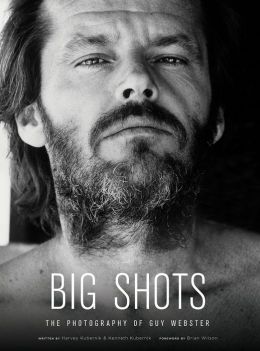
Jack Nicholson
Big Shots - Rock Legends and Hollywood Icons
Author: Guy Webster
Review By Michael Sherer
Publisher: Insight Editions
Posted: Jan 2015
(10642) Page Views
Born in ‘39, Guy Webster grew up in Beverly Hills during the 1950’s and early ‘60’s as the son of Oscar-winning lyricist Paul Francis Webster. This afforded Webster an inside view and easy access to the evolving entertainment world at a level that very few of his peers enjoyed. Webster was in L.A. to see it go through much change and expansion during the ‘60’s and ‘70’s, and was of the same generation of myriad talented and charismatic people beginning their careers at about the same time that Webster was his.
“Big Shots - Rock Legends and Hollywood Icons” is a first rate book of Webster’s photographs, released by Insight Editions of San Rafael, California. Large sized at 12.5’’ X 9.5’’ and with 270 pages richly chronicling the musicians, singers, actors and writers either in their prime, or shortly before becoming well known, Webster captured them all in his native Los Angeles. The thoughtful text was written by L.A. natives and brothers Harvey and Kenneth Kubernik. The forward was penned by Brian Wilson, an early subject and friend of Webster’s from his time photographing Wilson and The Beach Boys.
The text that Webster himself provides is a compelling story, and provides key context. He explains that photography evolved quite incidentally. The turning point was when he was called into the militarily in ‘61, stationed for basic training in Fort Ord, in Monterey, California. Having declared himself a conscientious objector and asking for an office job, the army wound up assigning him to decorate hundreds of Christmas trees, given that Webster was a decorator, artist, painter and sculptor. They then asked Webster if he knew anything about photography. Webster knew nothing, but lied and said he did. The army in turn asked him to teach photography to recruits, as well as how to develop film in a darkroom. Webster took out three photography books from the library, and learned what he needed to know.
When Webster was out of the army three months later, he wanted to continue pursuing photography. Initially aspiring to be a fine-art photographer in the mode of Irving Penn, whom he had just seen an exhibit of, he obtained some Pentax cameras from the “connected” father of a girlfriend, and was on his way. (The father was a mobster.) However, a call from friend and record producer Terry Melcher (son of Dorris Day) changed that course. Needing an album cover for his act the Rip Chords, Melcher asked Webster to take the photos for it. Webster loved music, and the combination of that and his new love of photography delighted him. From there, a flurry of musicians, actors and writers followed, including the Rolling Stones, Mamas and the Papas, The Beach Boys, The Byrds, The Doors, Simon & Garfunkel, Chicago, Charlton Heston, Rita Hayworth, Dean Martin, Natalie Wood, Igor Stravinski, Truman Capote, Zubin Mehta, Barbara Streisand, Jack Nicholson, Candice Bergen, Michelle Pfeiffer and Ted Danson, most of which are included in this book.
It’s a fine collection and excellent retrospective. With both color and black and white images taken at a wide range of sites and in Webster’s studio, this book captures the vibe and ethos of its time, yet doesn’t seem at all dated. Webster has his own voice and was able to photograph his subjects with an ease and naturalness that any photographer should strive for. See it for yourself.
Author Guy Webster Online
• Website
View More
Viewing Page 1 - of 4